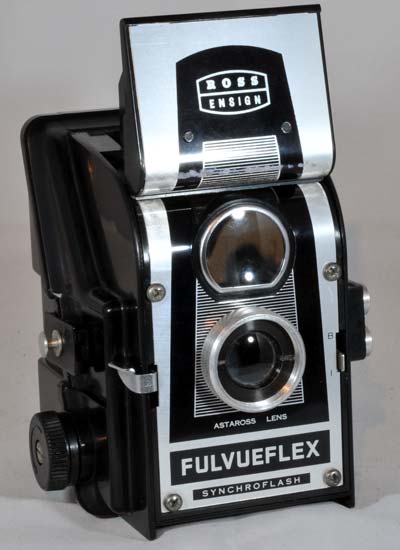Ross Ensign FulVueFlex
Specification

with Synchroflash
| Manufacturer | : | Ross Ensign |
|---|---|---|
| Produced | : | 1957 - 1959 |
| Classification | : | Medium Format |
| Body Type | : | Pseudo Twin Lens Reflex |
| Construction | : | Plastic |
| Film Type | : | 120 |
| Film Width | : | 62mm |
| Image Size | : | 2¼ x 2¼ in |
| No. of Images | : | 12 |
| Lens Type | : | Astaross Meniscus |
| Focal Length | : | 75mm |
| Focus Type | : | Fixed |
| Focal Range | : | 3m - inf. |
| Aperture Type | : | fixed |
| Aperture | : | f/11 |
| Shutter Type | : | Single blade return |
| Shutter Speeds | : | I*(1/40 sec), B |
| Size Closed(w x h x d) | : | 95 x 110 x 95 mm |
| Size Open(w x h x d) | : | 95 x 145 x 95 mm |
| Weight | : | 251g |
| * Measured on this camera | ||
Art Deco Credentials
![]()
Limited: Minor and insubstantial
- Produced after the main Art Deco period.
- Streamlined rounded corners.
- Linear pattern on face
- Chrome and black lens plate
- Cast plastic body and back.
- Chrome embellishments.
Description
Successor to the Ross Ensign Ful-Vue Super, this camera was a much simplified construction. Both body and lenses are made of plastic and it uses 120 film. This is the last camera to be produced by Ross Ensign. There are some reports that it was made in India but assembled in United Kingdom from 1957 to 1959. It is a pseudo TLR because there is no adjustment focus for distance.
The Astaross lens is fixed-focus with a fixed f/11 aperture. The shutter has a single instantaneous speed and a B setting. The body splits in half diagonally for film loading, released by turning a small metal plate on either side. It is synchronised for flash with flash sockets on the side. It has a flip up hood to shield the large viewfinder. The viewfinder is easy to use and is exceptionally bright. There is no tripod mount. The red window has no shield.
How to Use
This camera takes 120 film which is easily available from photographic outlets.
If you don't want to bother with an exposure meter, follow the guide shown. It is based on the 'Sunny 16' rule. Film is so forgiving and will produce acceptable results even when overexposed by 2 or 3 stops or underexposed by 1 stop.
Remember that the exposure guide in the camera user manual may not be helpful as it is based on the use of old film with a low ISO value.
The tables assume that the sun is at least 30 degrees above the horizon - that's 10am - 5pm on a summer's day (May-August) in the UK.
This camera has an f/11 aperture and a shutter speed of about 1/40s
The slow shutter speed means that you need to hold this camera steady when taking photographs.
Using ISO 100/125 film - shutter speed 1/40s
| Weather Conditions | Shadow Detail | Aperture | Exposure |
|---|---|---|---|
 Sunny SunnySnow/Sand | Dark with sharp edges | f/11 | +3 Stops Overexposed Acceptable |
 Sunny Sunny | Distinct | f/11 | +2 Stops Overexposed Acceptable |
 Slight Overcast Slight Overcast | Soft around edges | f/11 | +1 Stops Overexposed Acceptable |
 Overcast Overcast | Barely visible | f/11 | Good |
 Heavy Overcast Heavy Overcast | None | f/11 | -1 Stop Underexposed Acceptable |
 Open Shade Open Shade/Sunset | None | f/11 | -2 Stops Underexposed Not Acceptable |